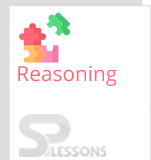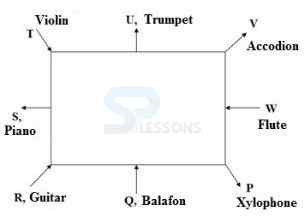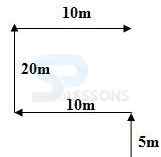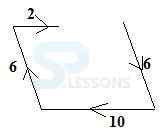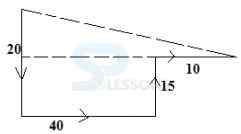 Introduction
Introduction
SBI PO 2019 - Main Examination, Objective Tests conducted in online Mode, has: a duration of 3 hours, 4 Sections, a total of 155 questions, a Maximum score of 200 marks, and, is followed by a Descriptive Test (English language) for a duration of 30 minutes. The 4 Sections are timed: Reasoning & Computer Aptitude, Data Analysis & Interpretation, General/ Economy/ Banking Awareness and English language. The section wise details are as shown below.
The Objective Tests are followed by a Descriptive Paper (Letter Writing + Essay Writing). There is a Negative marking in SBI PO Reasoning and Computer Aptitude Main exam and 0.25 marks are deducted for each wrong answer. Candidates must clear the cut-off in all the sections to qualify for the Group Exercises & Interview.
 Pattern
Pattern
| S.No. | Name of Test | Number of Questions | Mark | Duration |
|---|---|---|---|---|
| 1 | Reasoning & Computer Aptitude | 45 | Total Max. Marks 200 | 60 minutes |
| 2 | Data Analysis & Interpretation | 35 | 45 minutes | |
| 3 | General/Economy/Banking Awareness | 40 | 35 minutes | |
| 4 | English Language | 35 | 40 minutes | |
| Total | 155 | 3 Hours |
 Quiz
Quiz
Direction (1 - 5): Study the following information carefully to answer the given questions.
Eight players – P, Q, R, S, T, U, V and W sit around a square table in such a way that four of them sit on the four sides while the rest at corners. They play different instruments namely Xylophone, Balafon, Guitar, Piano, Violin, Trumpet, Accodion and Flute. Some of them are facing the centre while some are facing outside.(i.e away from the centre)
Note: Same directions means that if one person facing the centre then the other person also faces the centre and vice versa. Opposite direction means if one person is facing the centre then the other person faces outside and vice versa.
- Q faces the centre of the table and does not sit on any corner. V sits on one of the corner between the Flute player and Trumpet player. W sits second to the right of Balafon player who faces the centre.
- The Violin player sits third to the left of Q. S sits opposite to W. P sits on the corner exactly opposite to T. The Balafon player sits third to the right of Accodion player. The Xylophone player does not facing the centre.
- The Trumpet sits opposite to Q, also faces in opposite direction of Q and sits between Accodion player and Violin player. T who is the Violin player sits immediate right to the Piano player.
- The Piano player faces the same direction of the U. The immediate neighbors of Q are facing opposite directions.
- The Accodion player sits exactly opposite to Guitar player.
- The one who is on the immediate left of U is facing the same direction as W. R sits third to the left of W.
- A. P
B. U
C. T
D. Can’t be determined
E. None of these
- A. Guitar
B. Xylophone
C. Accodion
D. Can’t be determined
E. None of these
- A. The person who plays Flute
B. The person who plays Accodion
C. The person who plays Balafon
D. Trumpet
E. None of these
- A. None
B. One
C. Two
D. Three
E. Four
- A. P, V
B. P, R
C. V, R
D. Q, R
E. V, Q
1. A survey conducted by weapons watchdog, the Small Arms Survey, has revealed that 85% of the world’s 1 billion firearms are owned by the civilians. The survey further claimed that military stockpiles own for 13% and law enforcement agencies account for 2% of the total. The survey also stated that over the past 10 years, the number of firearms increased by 17%.
The Small Arms Survey, has revealed that the most of the world’s 1 billion firearms are owned by the civilians.
- A. The assumption is ‘definitely true’ i.e. it properly follows the statement of facts given.
B. The assumption is ‘probably true’ though not ‘definitely false’ in the light of facts given.
C. The data is inadequate i.e. from the facts given you cannot say whether the assumption is likely to be true or false.
D. The assumption is ‘probably false’ though not ‘definitely false’ in the light of facts given.
E. The assumption is ‘definitely false’ i.e. if the inference is not simply be drawn from the facts given or it contradicts the given facts.
- A. The assumption is ‘definitely true’ i.e. it properly follows the statement of facts given.
B. The assumption is ‘probably true’ though not ‘definitely false’ in the light of facts given.
C. The data is inadequate i.e. from the facts given you cannot say whether the assumption is likely to be true or false.
D. The assumption is ‘probably false’ though not ‘definitely false’ in the light of facts given.
E. The assumption is ‘definitely false’ i.e. if the inference is not simply be drawn from the facts given or it contradicts the given facts.
- A. 18 m
B. 20 m
C. 15 m
D. 25 m
E. None of these
- A. 10 m
B. 8 m
C. 12 m
D. 6 m
E. None of these
- A. 42.50
B. 50.25
C. 30.75
D. 45 m
E. None of these
Directions (1- 3): Study the following information to answer the given questions:
In a certain code,
“RAIL MADLY BUN JAR” is written as ‘19#L, 7%Y, 16$N, 12@R’
“JOB RAPID BOT MONKEY” is written as ‘28@B, 28#D, 10$T, 8%Y’
“MICRO BOAR RANSOM JUMP” is written as ‘21%O, 13$R, 20#M, 15@P’
“RADAR JUKE BANGLE MOD” is written as ‘14#R, 26@E, 28$E, 26%D’
1. The code for the word ‘RAN’ is
- A. 8%N
B. 8*N
C. 17#N
D. 16#N
E. None of these
- A. RUDE
B. REVERSE
C. RUPEE
D. RANDOM
E. None of these
- A. 20%K
B. 26%K
C. 28!K
D. 24!K
E. None of these
- A. SFUDBSCID
B. SFUDBEBID
C. SFUBIDDBS
D. SFUDBSBID
E. None of these
- A. SGYEOQS
B. SGXEQOD
C. SGYEOQD
D. SGYEQOD
E. None of these
Other Articles
 Study Guide
Study Guide
 Exams
Exams
| Competitive Exams - College Entrance Exams | |||
|---|---|---|---|
| Category | Notification | ||
| Diploma | NITC New Delhi | Goa Diploma Admissions 2019 | |
| Click Here For – All India Entrance Exam Notifications | |||
 Daily CA
Daily CA
 Job-Alerts
Job-Alerts
 SP Quiz
SP Quiz
| Competitive Exams - Practice Sets | |
|---|---|
| Category | Quiz |
| Quant Aptitude | Ratios and Proportions |
| Speed and Time | |
| Reasoning Ability | Puzzles |
| Current Affairs | Current Affairs |
 GK
GK
| General Knowledge for Competitive Examinations | |
|---|---|
| Topic | Name of the Article |
| GK - World | Tallest Residential Buildings |
| Different Countries Republic Days | |
| GK - India | Inflation Types |
| Indian States Symbols | |
| GK - Abbreviations | Sports Abbreviations |
| Indian Railways Acronyms | |
| GK - Banking & Insurance | Banking Sector Risks |
| Payment Banks – India | |
| GK - Science & Technology | Chemical Elements |
| Energy Transformation Devices | |
| Indian Research Institutes | |
